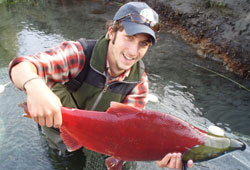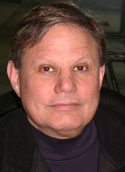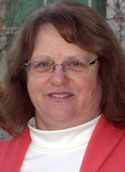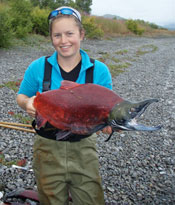 |
|||||||
| Ocean and Fishery Sciences Home Page | News | Make a Gift | |||||||
|
December 2008 | Return to issue home
New Genetics Lab Creates Data, Fosters Collaboration
Last autumn, Jim and Lisa Seeb joined the faculty in the School of Aquatic and Fishery Sciences (SAFS) with dual goals: to create the world’s most comprehensive and user-friendly genetic database of northern Pacific salmon, and to foster international collaboration by making that dataset freely available. Neither is a small task, but the Seebs are on the path toward achieving those goals through the establishment of the International Program for Salmon Ecological Genetics (IPSEG). Salmon are a cultural icon in the Pacific Northwest, and the salmon fishing industry is an economic driver throughout the Pacific Rim. Management and conservation of salmon stocks is therefore a major priority for multiple state and federal governments. But the life history of most Oncorhynchus species confounds open-water management. In the middle of the ocean, fish from US or Canadian rivers are indistinguishable from fish that originated in Japan or Russia. Moreover, salmon are often unintentionally caught as bycatch by vessels in search of other stocks, such as pollock. Scientists and policy-makers alike have been looking for ways to minimize these complications in their attempts to more fully understand the fishery. That’s where IPSEG comes in.
“We want to create very open, very transparent, very transferrable datasets” says Lisa. These new datasets, says Jim, will allow management agencies to “cut across boundaries.” Any interested party will have to access the same genetic information online. These species-wide datasets of Pacific salmon will be used to study migratory pathways in both marine and freshwater environments. This information will be very valuable to managers who will be able to better understand marine survival, shape mixed stock harvests to target stocks with surplus production, and allocate marine catches to stock of origin. These data will lead to improved fishery management with the corollary preservation of genetic diversity and long-term sustainability. But how does one go about creating such a dataset? First, one must identify gene markers that distinguish populations from each other. Second, those markers must be identified in a way that can be readily duplicated. For the Seebs, that means using single nucleotide polymorphisms, or SNPs. SNPs, according to Jim, provide the most information about the migration of both adult and juvenile salmon. They can be used in studies of stock identification and ecological genetics. SNPs are also easy for labs to pull out of raw genetic material, regardless of equipment. “Our whole objective is to move to markers of DNA sequence because anywhere you are, you can use any instrument,” says Lisa.IPSEG utilizes high-throughput genotyping equipment for their analysis. “We are fortunate to have the latest high-throughput instruments in our lab, and University core facilities provide us a unique opportunity to invest in next-generation sequencing,” says Lisa.
The revolutionary new technology has exponentially increased the amount of DNA sequence available for SNP discovery. While working for the Alaska Department of Fish and Game during the five years prior to joining SAFS, the Seeb lab was able to sequence 89,000 base pairs of DNA. Since joining the SAFS program they have sequenced 500 million base pairs, at a cost of about $60,000. This winter they will get their first sequences from the UW High-Throughput Genomics Unit who can produce four billion base pairs per week at a cost of about $7,000. When asked how they handle the seemingly daunting task of making sense of four billion pieces of information, Lisa says, “We take it in small chunks.”Those small chunks have proven enormously valuable. The new DNA sequence provides thousands of new SNPs, up from just 150 that were available at the outset of the project. The number of known markers will only continue to grow. “We’re at UW,” says Jim, “which has resources unmatched anywhere else in the world.” “Besides the advantages of being in a big university with core services, we have a host of new faculty colleagues who provide ideas and inspiration” adds Lisa. The Seebs believe that the unique structure of a research university was a key factor in the program’s successful bid for a $4 million grant from the Gordon and Betty Moore Foundation. The grant not only enabled the program’s creation but also, the Seebs hope, will save research dollars in the long term. Before now, various labs could not easily share data, so some specimens were repeatedly analyzed in efforts to create proprietary - and repetitive - databases. Through the new project, data will only need to be created once, then shared with colleagues in other agencies. UW’s ability to host visiting scientists was also important to securing the Moore Foundation grant, and IPSEG is fulfilling the promise to promote international collaboration. In October, IPSEG hosted a two-day workshop in Hokkaido, Japan, during which participants planned joint studies for SNP discovery and SNP detection. This workshop was followed in November with a two-week visit by six students and post-doctoral fellows from Japan, Russia, and Korea who came to the UW to learn new SNP genotyping techniques. “We're in a great position to work with fisheries students who will be the next generation of agency and academic leaders in the Pacific Rim,” says Lisa. * Photos courtesy of Jim Seeb December 2008 | Return to issue home | |||||||
|
|||||||




